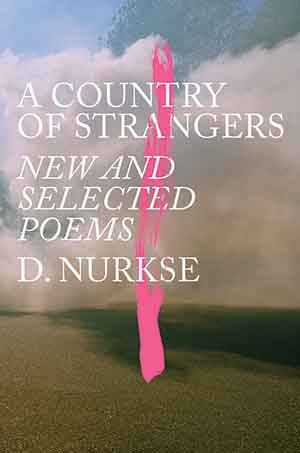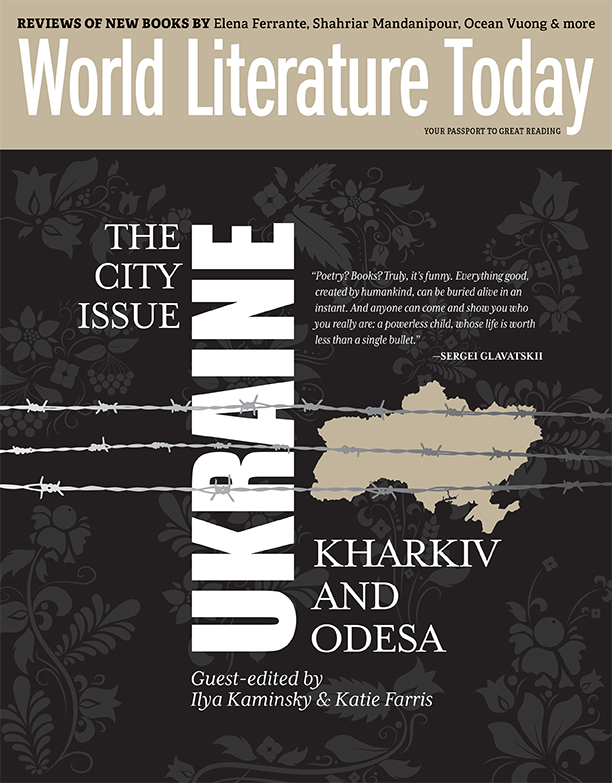A Country of Strangers: New and Selected Poems by D. Nurkse
 New York. Knopf. 2022. 286 pages.
New York. Knopf. 2022. 286 pages.
AT THE CORE of A Country of Strangers: New and Selected Poems, is a double (external/internal) exile that causes the poet to periodically absent himself from himself, others, and the world. The poet suffers from a “pain of nothing” and is unsure of its own existence: “Turn and face yourself / if there is a self.” He sees life “like water in cupped hands” and himself as a passing cloud, a pine cone, a nonfinite being afflicted with the “suffering of this pronoun I.”
Love is not immune to this. The force that attracts soon estranges and, like a kerf, stresses the foreignness of bodies and minds—an apocalypse waiting to punish a transgressive act. It is Tristan and Isolde’s dream of a lifetime of normal happiness while facing punishment. The tension between their longing for innocence lost and the subversiveness of their love is matched by God’s helplessness not to love them:
Doesn’t God love them
because they are like him,
too broken to obey
the rules of death?
(“The Living Spring”)
The poet also shuttles back and forth between his poetic world and reality and lives life through a glass prism or behind a white curtain, something that Joanna Pollakówna defined as a shadow descending between reality and the image created from it. When emerging from his inner world of reflections and connections, the poet shows an “extraordinary grasp and insight, uttered with an uneven vigor sometimes exasperating, seemingly wayward, but really unsought and inevitable,” which takes one’s breath away. These words, used by Thomas Wentworth Higginson to describe Emily Dickinson’s poetry, apply to D. Nurkse as well, as both share an ability to seize an illuminating instant from which springs the full poem. Such flashes of reality establish a balance between the poet’s inner world and the real world and reconcile intuition and intellect.
Nurkse’s sense of human fragility is expressed through a flexible writing palette (Japanese renga, concrete poetry, lyrical poetry, street language), an international set of places (Estonia, Brooklyn, Armorique, Canaan, Rome, or the imaginary Olmos), and a cultural universe ranging from the troubadours to Freud, World War II, nuclear physics, and current events. Rife with connections and reflections, such poetry prolongs words into silence. In an interview for American Life in Poetry, the poet said that the double space between stanzas “comes at you from different sides and has a great deal of resonance.” It is a place “to put the narrative elements” of the poem. In so doing, the poet creates another layer of meaning. He enshrines intimate and political vignettes into poetic myths and inscribes culture and language in the palimpsest of history.
In his most recent poems, the Covid pandemic experience of the past two years appears not as raw depression or anger but as a watermark in history’s cabinet of horrors. Aphorisms unite transient detail and cosmic eternity. “God’s silence / is the silence of a cricket”; parenthood is defined as “to wait all our lives / for a single moment.” With the humbleness of one who senses that everything has already been said and done, Nurkse embroiders the world’s multimillenarian human opus with metamythical variations on existential longings: birth, childhood’s innocence, love, justice, violence, passion, loneliness, and the mysteries of the untamed mind. He loans his voice to a cloud of witnesses, loved ones and strangers alike; he reverses linear modernity to conjure past voices from “signs on the blank page,” in order to erase oblivion and stimulate imagination. If his portraits of humans probe the untamed regions of the mind, his portraits of places map geographical and cultural borders with an obsessive longing, as in his long paean to Brooklyn, “A Night in Brooklyn,” where ghosts and neighborhoods parade in freeze-frames.
Nurkse, who admits to writing slowly, is in fact a tireless writer. Through his forty-year career, he has published poems in English and in translation in seventy-seven magazines from eleven countries situated on three continents, and has been anthologized twenty-eight times in the US, the UK, and Canada. His collected works one day will be much more substantial than the volume under review, which comes to us twice-culled. Before the publication of each volume, he made a selection that, in his words, gives the absent poems a zen quality of “contributing to any intensity the poems muster.” He made a second selection for A Country of Strangers with his editor, Deborah Garrison. Their friendly differences created a push-pull between “the poems as thematic [Nurkse] and the poems as things-in-themselves [Garrison].” The book opens with the newest poems, written during the past five years. The next selections from the eleven published volumes appear in the order in which they were written. Thus Staggered Lights, written in the mid-1980s but published in 1990, appears before Shadow Wars, which was written slightly later but published in 1988. Similarly, Love in the Last Days (2017) appears before A Night in Brooklyn (2012). This organization delineates a tightly knit poetic spiral to which recurring themes impart their own rhythm, namely a long declension of life stages toward death that involve returning to the past and recapturing the innocence and creativity of a child.
The titular theme, with its implied melancholy, is also the title of the book’s first section. The despair and trauma of exile are palpable: they are the poet’s own exile, his postmemory of two generations of family exiles in World Wars I and II, and his empathy with today’s world exiles. In the eponymous poem, a timeless composite group of war refugees, including the poet, wait in front of rail tracks to flee an unnamed, desolate country that can be found on no map—Sheol—and “the steel parallels / converge on a fixed point / that exists only in the past.” Returning to the past does not produce solace, understanding, or reconciliation, however, and soon the dead impose a new order and a new language. Decaying streets, war, and illness expose the darkness that is descending on our world. Prophetically, Death comes in a white Lexus or as a salesman. Today, as one thousand years ago, people live on the brink in a dehumanized universe, and the dying strapped to their hospital bed hear the living plan strategies for survival or face “the strange machine / that can decipher the human face.”
Alice-Catherine Carls
University of Tennessee at Martin
When you buy a book using our Bookshop Affiliate links on this page, WLT receives a commission. Thank you for your support!





























